Chittagong's PCT gives carriers new Bangladesh options
Bangladesh’s port of Chittagong’s recently inaugurated Patenga Container Terminal (PCT) is ramping up its operations, ...

Equipment shortages in Asia will get worse over the next two weeks, say carriers, impacting both deepsea and intra-Asia trades.
Maersk has told customers the strong cargo demand out of Asia Pacific would likely continue throughout the second-quarter, but…
“Schedule reliability is impacted by two main factors: recent delays from Europe via Suez Canal; and lower port productivity, especially on transpacific and European trade routes,” the company added.
As a result, the shortage of empty containers remains an “industry-wide challenge” across Asia, said ...
Keep our news independent, by supporting The Loadstar
Container spot rates diverge: to Europe still falling, but firmer to the US
Volume surge and an early peak season? 'Don't celebrate too soon,' warning
Hapag-Lloyd won't take bookings if port congestion leaves cargo stranded
Ecommerce likely the front-runner in resurge of transpacific trade after deal
China-US trade tariff pause could drive a rebound for transpacific rates
Service chaos from trade ban with India a problem for Pakistan shippers
Airfreight rates ex-China 'loss-making', but hopes of a trade deal stay high

Comment on this article